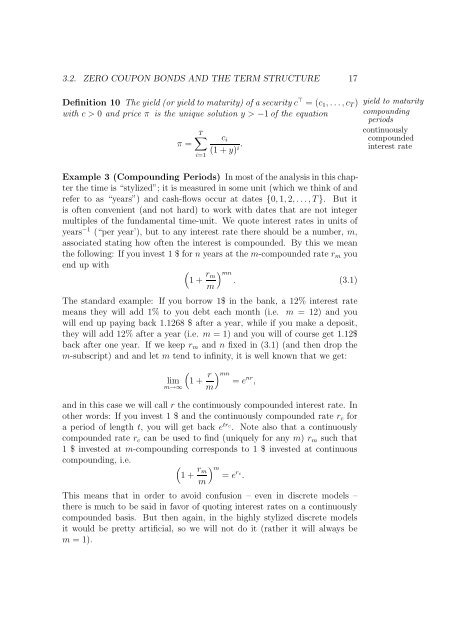Lecture Notes for Finance 1 (and More).
Lecture Notes for Finance 1 (and More).
Lecture Notes for Finance 1 (and More).
Create successful ePaper yourself
Turn your PDF publications into a flip-book with our unique Google optimized e-Paper software.
3.2. ZERO COUPON BONDS AND THE TERM STRUCTURE 17<br />
Definition 10 The yield (or yield to maturity) of a security c ⊤ = (c1, . . .,cT)<br />
with c > 0 <strong>and</strong> price π is the unique solution y > −1of the equation<br />
π =<br />
T�<br />
i=1<br />
ci<br />
(1 + y) i.<br />
Example 3 (Compounding Periods) In most of the analysis in this chapter<br />
the time is “stylized”; it is measured in some unit (which we think of <strong>and</strong><br />
refer to as “years”) <strong>and</strong> cash-flows occur at dates {0, 1, 2, . . ., T }. But it<br />
is often convenient (<strong>and</strong> not hard) to work with dates that are not integer<br />
multiples of the fundamental time-unit. We quote interest rates in units of<br />
years−1 (“per year’), but to any interest rate there should be a number, m,<br />
associated stating how often the interest is compounded. By this we mean<br />
the following: If you invest 1 $ <strong>for</strong> n years at the m-compounded rate rm you<br />
end up with<br />
�<br />
1 + rm<br />
m<br />
� mn<br />
. (3.1)<br />
The st<strong>and</strong>ard example: If you borrow 1$ in the bank, a 12% interest rate<br />
means they will add 1% to you debt each month (i.e. m = 12) <strong>and</strong> you<br />
will end up paying back 1.1268 $ after a year, while if you make a deposit,<br />
they will add 12% after a year (i.e. m = 1) <strong>and</strong> you will of course get 1.12$<br />
back after one year. If we keep rm <strong>and</strong> n fixed in (3.1) (<strong>and</strong> then drop the<br />
m-subscript) <strong>and</strong> <strong>and</strong> let m tend to infinity, it is well known that we get:<br />
�<br />
lim 1 +<br />
m→∞<br />
r<br />
�mn = e<br />
m<br />
nr ,<br />
<strong>and</strong> in this case we will call r the continuously compounded interest rate. In<br />
other words: If you invest 1 $ <strong>and</strong> the continuously compounded rate rc <strong>for</strong><br />
a period of length t, you will get back etrc . Note also that a continuously<br />
compounded rate rc can be used to find (uniquely <strong>for</strong> any m) rm such that<br />
1 $ invested at m-compounding corresponds to 1 $ invested at continuous<br />
compounding, i.e.<br />
�<br />
1 + rm<br />
m<br />
� m<br />
= e rc .<br />
This means that in order to avoid confusion – even in discrete models –<br />
there is much to be said in favor of quoting interest rates on a continuously<br />
compounded basis. But then again, in the highly stylized discrete models<br />
it would be pretty artificial, so we will not do it (rather it will always be<br />
m = 1).<br />
yield to maturity<br />
compounding<br />
periods<br />
continuously<br />
compounded<br />
interest rate

















